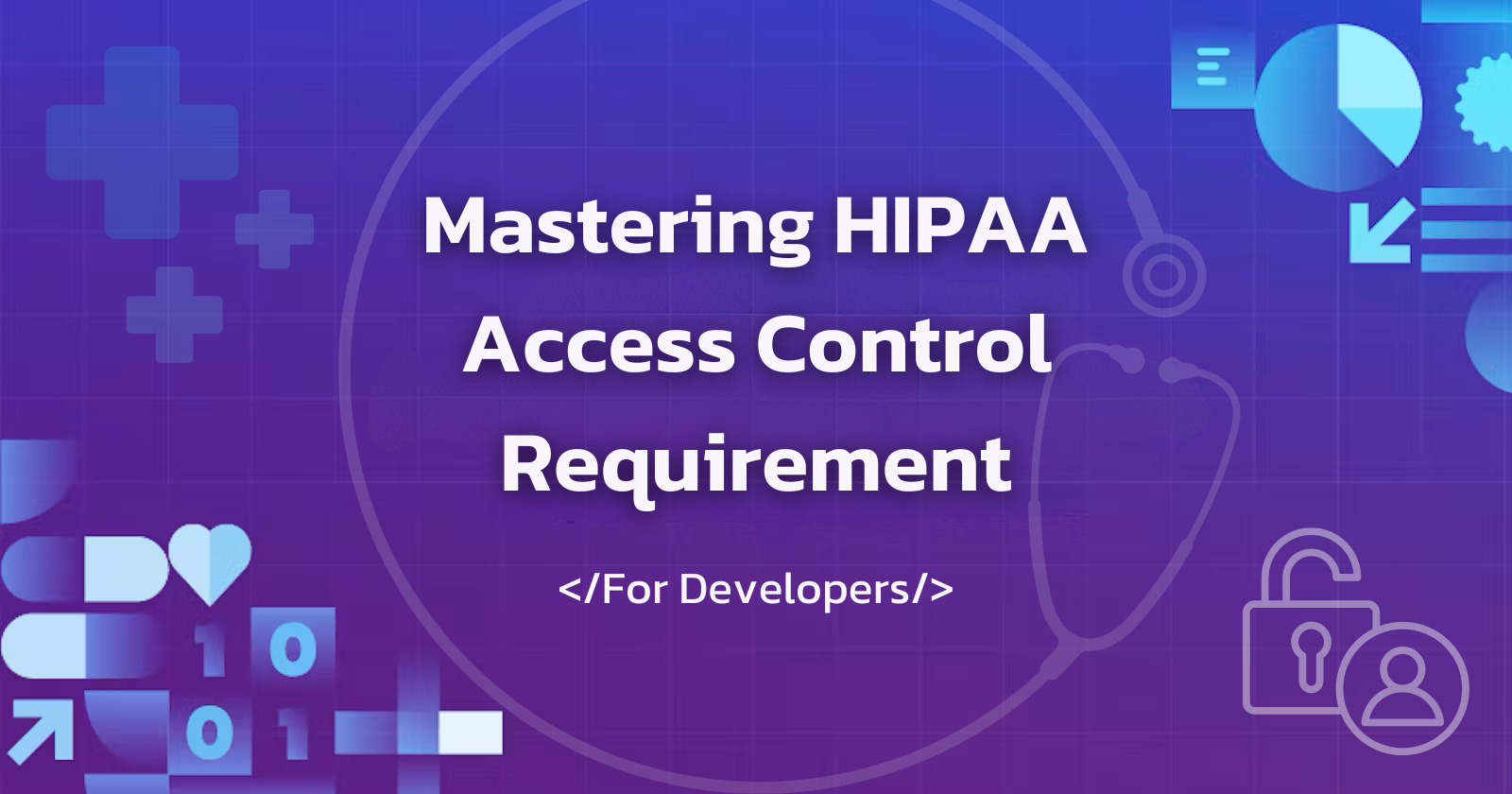Mastering HIPAA Access Control Requirements: A guide for Developers
 Vanessa Villa
Vanessa Villa
Introduction
Access control is a vital component of both operational security and compliance, especially in the Healthcare space. Access control systems help protect sensitive patient data, ensure the safety of patients and staff, and maintain the integrity of healthcare operations. As healthcare includes managing data across multiple departments and systems, access control becomes essential to preventing unauthorized access to protected health information (PHI), securing critical systems, maintaining federal compliance, and protecting patient privacy.
We'll explore best practices for access control in healthcare, focusing on how it aligns with HIPAA compliance and enhances security across systems. An example of how you may centralize access control to lower security risks with a cloud based authorization system will also be covered.
Understanding Healthcare Access Control
Access control in healthcare refers to a set of principles and practices designed to manage who can access various areas and data in a healthcare environment.
Healthcare facilities must balance tight security controls with the need for smooth operations. Clinicians, nurses, and administrators require quick access to systems and areas while adhering to the hospital's security policies.
Hospital access control systems typically oversee physical entry points like doors as well as digital access to sensitive information, such as electronic health records (EHRs).
Physical Access Control: Governs who can enter specific areas like operating rooms, medication storage, or labs.
Digital Access Control: Manages access to critical IT systems, including patient databases, EHRs, and medical devices.
In some cases, the physical access points can also be modeled and restricted digitally, like being able to grant an equipment technician badge access to the lab for a day. For today, we are going to deep dive into the digital aspect of healthcare access control solutions.
HIPAA and Access Control Requirements
HIPAA (Health Insurance Portability and Accountability Act) sets strict requirements for controlling access to patient data. Under HIPAA, healthcare organizations must ensure that only authorized personnel can access PHI, whether it's stored digitally or in physical formats.
Key HIPAA access control provisions include:
Unique User Identification: Each user must have a distinct identifier to track their access to sensitive data.
Emergency Access Procedures: Systems must provide emergency access protocols to ensure care in urgent situations.
Audit Controls: Systems should maintain logs to record access activities for compliance purposes.
Notification of 3rd party Access: if a User’s data is being shared with a 3rd party, like insurance for example or another healthcare provider, the user has the right to be notified.
Authorization within HIPAA refers to granting access to patient information based on specific roles and responsibilities. For example, a nurse may have access to patient care records but not billing records. HIPAA mandates that healthcare providers limit access to the minimum necessary data for each employee’s role. The HIPAA Authorization is valid for life unless the patient revokes access or an expiration date is put in at the time of signing.
Patient privacy is essential in retaining patient trust and a healthcare facility’s access control mechanisms play a significant part in that.
Common Models of Access Control in Healthcare
We have covered that we are controlling access to PHI as well as the specific requirements that are needed to be fulfilled. Let’s get into common models used to control access and what they are best used for.
Role-Based Access Control (RBAC)
Role-Based Access Control is one of the most common access control models used in healthcare. It assigns permissions based on an individual's role within the organization. For instance, a doctor may have access to patient health data, while an administrative staff member may only access billing information. RBAC is highly effective in preventing unauthorized access and ensuring that users only have access to information they need to perform their jobs.
Discretionary Access Control (DAC)
With DAC, otherwise known as Relationship Based Access Control (ReBAC), the owner of a resource—such as a department head or IT admin—determines who can access certain data or areas. This model allows for flexibility but can be more challenging to maintain compliance in large organizations if not properly logged and documented. .
Mandatory Access Control (MAC)
MAC, or Attribute Based Access Control (ABAC), offers stricter controls by limiting access based on predefined security policies designed on any specific attribute of the user or resource. It’s typically used in high-security areas, such as research labs or neonatal wards, where access needs to be rigorously controlled and monitored. Imagine being able to restrict access based on the time of day or if a specific patient is in the ward or not.
For more information on RBAC, ReBAC, and ABAC, check out this blog which compares them and provides a structure on how to choose which is right for you.
Best Practices for Implementing Healthcare Access Control
A robust healthcare access control solution can include RBAC but with complexity, may become untenable at scale.. There are other features, design decisions, and procedures to effective access control.
Features and Procedures
Multi-Factor Authentication (MFA): Multi-Factor Authentication adds an additional layer of security by requiring users to verify their identity through multiple means, such as a password, fingerprint, or pin number. This is especially important in areas with highly sensitive data, like pharmacies or medical records departments. Implementing MFA reduces the risk of credential theft and unauthorized access.
Well-Designed Access Control: RBAC is great for starting an access control model. When organizational complexity and high sensitivity data comes into play, it may not cover the organizational needs. What is best practice here is to model out your security policy using a combination of RBAC, ReBAC, and ABAC to create the most effective and most manageable model. For a guide on how to achieve that, check out this blog here.
Audit and Monitoring Systems: Continuous auditing and monitoring are essential to ensure compliance with HIPAA’s access control standards. Logging access attempts, flagging unauthorized access, and generating real-time reports help identify potential security breaches early.
Emergency Access and Lock down Procedures: Healthcare environments require access control systems that can seamlessly integrate with emergency procedures. During a lock down or emergency, access systems should restrict entry to high-risk areas and ensure that only authorized personnel have access during critical situations.
Technologies
There is a lot to keep in mind, even in just the design process of an access control system. When implementing it and integrating in the broader system, a centralized place to manage these policies and monitor activities in real time is vital.
Cloud-based access control provides scalability and remote management capabilities for large healthcare systems. These solutions allow administrators to adjust permissions and monitor access from anywhere. Cloud solutions must comply with strict security protocols to ensure HIPAA compliance and safeguard sensitive information. This means having secure audit logs which are tamper proof and maintaining those logs for a minimum of 6 years. To find out more, check out this walk through of audit logs and how to make sure they are HIPAA compliant.
Challenges and Solutions in Healthcare Access Control
Privilege Creep
Privilege creep occurs when employees accumulate more access rights than necessary, often because they change roles without having old permissions revoked. To combat this, healthcare organizations should regularly audit user access and remove unnecessary privileges.
Visitor and Vendor Access Management
Visitors and vendors must also be closely monitored. Temporary access controls, such as issuing visitor badges with restricted permissions, can help healthcare facilities manage non-staff access and ensure security. Adding expiry dates on access can also help manage temporary permission.
Ensuring Compliance with HIPAA
Proving Regulatory Compliance
Access control systems and secure logging play a critical role in compliance with HIPAA by restricting who has access to sensitive patient data and documenting it. By maintaining detailed logs of who accessed what data and when, healthcare organizations can prove they are adhering to HIPAA standards during any audits. Remember that those logs must be in-editable and have a retention policy of at least 6 years and have certain fields included. For more information on secure audit logging and HIPAA, check out this comprehensive guide.
Consequences of Non-Compliance
Non-compliance with HIPAA’s access control rules can lead to severe penalties, including fines and legal action. For instance, a hospital that fails to prevent unauthorized access to patient data may face penalties ranging from $100 to $50,000 per violation, depending on the number of patients impacted, what data was exposed in the breach, and the preventative measures that were in place while the breach occurred.
This not to mention the impact that would happen on the patient’s trust of that healthcare system. Any exposed data from a breach can then be used in other ways like identity theft, phishing scams, or sold off for other purposes. That broken trust is hard to repair, and the consequences can ripple for years to come
Conclusion
Access control is a cornerstone of healthcare security, ensuring that sensitive data and critical areas remain protected while maintaining operational efficiency. As healthcare systems continue to be a target in cyber attacks, keeping up with advancements in access control technologies and maintaining compliance with regulations like HIPAA are essential. Senior engineers must design systems that balance security, functionality, and compliance, ensuring that their healthcare organizations remain safe, efficient, and secure.
Subscribe to my newsletter
Read articles from Vanessa Villa directly inside your inbox. Subscribe to the newsletter, and don't miss out.
Written by
